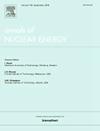Feasibility study of Th–Pu based micro-heterogeneous duplex fuels in PT-SCWR
IF 1.9
3区 工程技术
Q1 NUCLEAR SCIENCE & TECHNOLOGY
引用次数: 0
Abstract
The shortage of uranium and the growing demand for clean and reliable energy make it urgent need to explore alternative fuels. The development and implementation of thorium-based fuel can help in solving key challenges faced by the nuclear industry. This study addresses the challenges of limited natural uranium supply, nuclear waste management and proliferation concerns by exploring the use of duplex fuel in the PT-SCWR. The PT-SCWR Generation IV reactor types represents next stage of advancement in the nuclear reactor field with enhanced efficiency. Micro-heterogeneous duplex fuel may help in extending the burnup cycle and provide various operational benefits. This feasibility study explores the potential use of duplex fuel in PT-SCWR by analyzing its neutron-physical properties at both the pin-cell and 64-element fuel assembly levels. A series of 2-D lattice physics calculations with depletion is conducted using the DRAGON code with particular emphasis on burnup depth, reactivity coefficients, and fissile inventory. The computational model is verified against the PWR AP1000 pin cell model which demonstrated trends consistent with existing literature. The results are categorized into two different categories named performance metrics and operational safety characteristics. Homogeneous fuel served as a baseline for comparison, while different enrichment levels of fissile concentration () were analyzed in duplex configuration. It is observed in performance evaluations that duplex pellets exhibit smoother infinite multiplication factor curves which leads to increased cycle burnups and lower initial reactivity with a slower rate of reactivity decline. Safety evaluations revealed negative temperature coefficients of reactivity and supports nuclear non-proliferation due to its lower fissile inventory ratio (FIR). The micro-heterogeneous duplex pellet emerges as a viable fuel option for PT-SCWR fuel providing several performance and safety benefits to its predecessor.

求助全文
约1分钟内获得全文
求助全文
来源期刊

Annals of Nuclear Energy
工程技术-核科学技术
CiteScore
4.30
自引率
21.10%
发文量
632
审稿时长
7.3 months
期刊介绍:
Annals of Nuclear Energy provides an international medium for the communication of original research, ideas and developments in all areas of the field of nuclear energy science and technology. Its scope embraces nuclear fuel reserves, fuel cycles and cost, materials, processing, system and component technology (fission only), design and optimization, direct conversion of nuclear energy sources, environmental control, reactor physics, heat transfer and fluid dynamics, structural analysis, fuel management, future developments, nuclear fuel and safety, nuclear aerosol, neutron physics, computer technology (both software and hardware), risk assessment, radioactive waste disposal and reactor thermal hydraulics. Papers submitted to Annals need to demonstrate a clear link to nuclear power generation/nuclear engineering. Papers which deal with pure nuclear physics, pure health physics, imaging, or attenuation and shielding properties of concretes and various geological materials are not within the scope of the journal. Also, papers that deal with policy or economics are not within the scope of the journal.
 求助内容:
求助内容: 应助结果提醒方式:
应助结果提醒方式:


